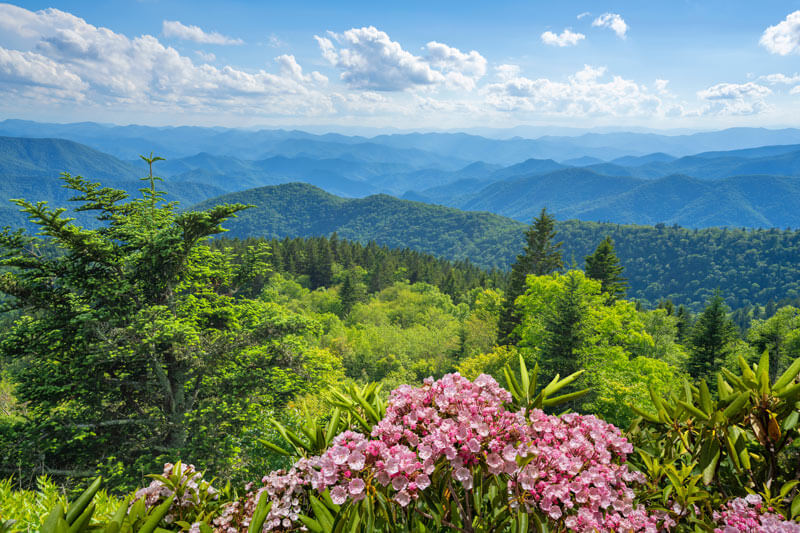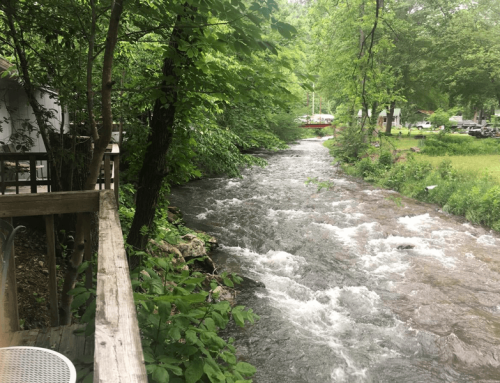Wildflower season has arrived in the Smokies! As winter fades and spring brings new life, these ancient hills are transformed into a vibrant and fragrant wonderland. With over 1,500 species of flowering plants in the area, 80 percent of them are wildflowers, and you can catch a glimpse of all the eye-popping colors right now. Get ready to soak up the natural splendor of spring wildflowers in the Smoky Mountains at these ten incredible spots.
-
Spring Wildflower Pilgrimage
Since 1950, the annual Spring Wildflower Pilgrimage in the Great Smoky Mountains National Park has drawn hundreds of people from all around the world. The organization offers wildflower walks guided by professionals as well as educational exhibits and other opportunities to explore the Smokies’ invaluable natural and cultural resources. This year, you can get in on the action at the 72nd Annual Pilgrimage being held April 26-30, 2022. Visit their website here to register.
-
Cades Cove Loop
Cades Cove is one of the most popular areas in the Great Smoky Mountains National Park, but if you visit during the spring you’ll beat the summer crowds. AND you’ll be treated to a gorgeous display of colors along the 11-mile loop. Meander through the valley for views of stunning blooms. If you’re up for a little more exploration, venture down Forge Creek and Parson Branch Road where you’ll discover breathtaking fields of wildflowers. Then at the end of Forge Creek Road, look for the trailhead to Gregory Ridge Trail. The first couple of miles along this trail offer up premium wildflower viewing.
-
Porters Creek
In Porters Creek, located in the Greenbriar area of the Great Smoky Mountains National Park, you’ll find some of the most incredible natural displays of spring wildflowers anywhere in the world. The groundcover is teeming with bright colors, which makes for some amazing photographs. Fringed phacelia blankets the ground all the way up to the cascading Walking Fern Falls. Along the way, you’ll spot large clusters of purple dwarf irises, mayapples, and bishop’s caps. Later in May, the white trilliums, little white squirrel corn, and Dutchman’s breeches are in full bloom.
-
Little River Trail
If you have young children, Little River Trail is a great wildflower hike. Located in the park’s historical district of Elkmont, this 4.9-mile roundtrip hike is a wide, flat gravel trail that rambles beside a tranquil stream with scenic views, historic cottages, a stunning 20-foot waterfall, and of course, spring wildflowers. You’ll see vibrant rhododendrons, yellow trillium, Canadian violets, hepaticas, and trailing arbutus. (Local tip: Come back in June to see the world-famous synchronized fireflies that visit this area every summer!)
-
Metcalf Bottoms Trail
The entire family will enjoy this beginner friendly hike. Early spring is the best time to spot spring ephemerals like columbine, pink lady slipper orchids, purple violets, and crested dwarf iris. But come quick because these wildflowers only make a brief appearance before going dormant when the trees above them fill with leaves and cast a long shadow. After taking in the beauty of the blooms, keep hiking to see a historic schoolhouse and the Walker Sisters Cabin.
-
Schoolhouse Gap Trail
A 2.2-mile trail with scenic mountain views, Schoolhouse Gap Trail begins at Laurel Creek Road and gradually increases in elevation with a slight incline up to Schoolhouse Gap. You’ll see Virginia bluebells, pink lady slippers, golden aster, and a variety of trilliums with each step forward.
-
White Oak Sinks
Right off of Schoolhouse Gap Trail, you’ll find White Oak Sinks, one of the most protected areas of Great Smoky Mountains National Park. Many Appalachian families once called this area home, but now it is occupied by a local colony of bats. In an effort to protect these creatures that are crucial to the environment, it’s only open for a limited amount of time each spring. If you’re lucky enough to visit when it’s open, you’ll be treated to a luxurious blanket of spring wildflowers like trilliums, jack-in-the-pulpits, bluebells, and shooting stars.
-
Blue Ridge Parkway
Over on the North Carolina side of the Smokies, head to the Blue Ridge Parkway. The area’s high rainfall, rich soils, and mild climate come together to form the perfect home for a wide variety of species. Graveyard Fields and Craggy Gardens are two popular spots for spring wildflower viewing in the Smoky Mountains. In early spring, the forest floor is covered with wild ginger, spring beauty, trout lily, trillium, larkspur, foamflower, and jack-in-the-pulpit. Later in the wildflower season, you’ll see blooms like Turk’s cap lily, meadow rue, evening primrose, impatiens, turtlehead, aster, black-eyed Susan’s and so much more.
-
Oconaluftee River Trail
The Oconaluftee River Trail inside the Great Smoky Mountains National Park is an easy 3-mile roundtrip hike along the river with a wide smooth path that’s perfect for strollers, wheelchairs, and bicycles. It’s also one of only two trails in the park that allows dogs. (The other is the Gatlinburg Trail, a 1.9-mile hike from the Sugarland Visitor Center to the outskirts of Gatlinburg, TN.)
You’ll see white trillium, columbine, crested dwarf iris, phacelia, purple violets, and pink lady slipper orchids, among other blooms. In addition to viewing and photographing spring wildflowers, this trail offers the opportunity to learn about the inspiring stories of the East Band of the Cherokee. The trail actually ends at the boundary of their reservation. Return to the visitor’s center or explore the local shops. As you’re exploring and snapping shots of the wildflowers, keep an eye out for the wild elk herd. These magnificent beasts are often seen in the fields around the Oconaluftee Visitor’s Center and along the trail. Just be sure to keep a safe distance of 150 feet or more and take your photos from there.
-
Pisgah National Forest
Pisgah National Forest boasts two phenomenal spots for viewing spring wildflowers. The fittingly named Pink Beds Valley is known for its vast fields of pink wildflowers, like mountain laurel and rhododendron. From the balds of Roan Mountain, a 6,285-foot ridge that runs along the state line between Tennessee and North Carolina, you’ll experience breathtaking panoramic views of the colorful rhododendron fields in the valley down below.
As you venture out into the Smokies on your search for the perfect spring wildflower photograph, please remember the time-honored advice: Take nothing but pictures, leave nothing but footprints.
Learn more about the botanical beauty of the Smoky Mountains on this episode of the Gateway to the Smokies Podcast, where host, Joseph McElroy talks with special guest, Adam Bigelow, a well-known environmental and community activist as well as an outstanding musician.




